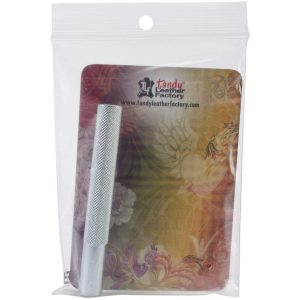
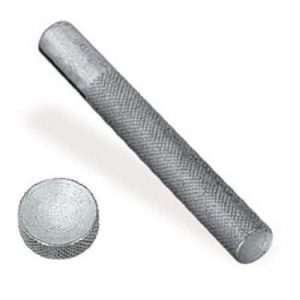
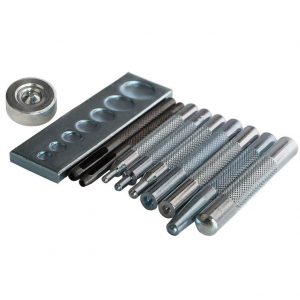
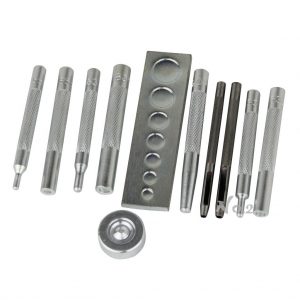
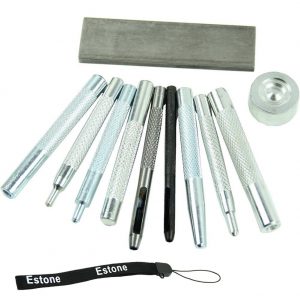
To snug attractive brass and copper rivets (clenches or clinches) to a leather belt or wallet, hobbyists use a special tool called a rivet setter. By means of any craft hammer for leather, a river fixator will make sure a nice-looking burr seats properly.
Besides aesthetics, clenches are necessary to join two pieces of cowhide together in a very tight way. Sometimes hobbyists do not even sew — they prefer riveting over the use of a needle and thread. Tightly attached clinches are capable of holding the pieces permanently (for instance, classic blue jeans with clenches made by Levi). It’s a very attractive way to attach leathern pieces together.
There are quick and copper rivets (washers) — each type can be set by hand by means of a fixator or with a special machine. The major task for any hobbyist is to pick a durable leatherworking tool, preferably the one capable of coping with metal clinches. Also, enduring punchers can handle putting clinchers on any hard surface — an anvil or marble. But mostly it is the best choice for leathercraft projects.
5. Estone Set of 11 Craft Tools for Riveting — Best Rivet Setter for Small Projects!
 It’s a myth that a basic set of high-quality river fixators will cost over $100. Estone kit is offered at the price of less than $11 and has 11 instruments for punching and riveting. Made of durable metal this set will do for novices who make their first leathern projects (like adding stylish clenches to a cowhide belt).
It’s a myth that a basic set of high-quality river fixators will cost over $100. Estone kit is offered at the price of less than $11 and has 11 instruments for punching and riveting. Made of durable metal this set will do for novices who make their first leathern projects (like adding stylish clenches to a cowhide belt).
| Pros | Cons |
| Covers more basic crafting needs than just riveting — for example, it includes 2 solid punches; | There are no instructions for using any of the included instruments, though the kit is offered for novices; |
| The cheapest basic kit with a few instruments for daily uses; | Holes made by punch instruments may turn to be inaccurate; |
| Enduring due to the full-length metal as a major material; | Has no a decent package — just a cheap small envelope, without any box; |
| – | Snap fixating instruments come without any marking; |
For less than $11, a hobbyist gets 11 river setters for rawhide of decent quality. Surely, it is a pretty basic kit that can’t be recommended to anyone but novices.
4. No.2 Warehouse 11pcs DIY Craft Tools — Best Kit with 7 Different Setters!
 Another 11-piece kit with multiple instruments capable of making punches, attaching leathern parts or for decorating. It can be recommended for those artists who need a variety of durable tools for riveting jobs.
Another 11-piece kit with multiple instruments capable of making punches, attaching leathern parts or for decorating. It can be recommended for those artists who need a variety of durable tools for riveting jobs.
| Pros | Cons |
| Includes a clean cloth (not rawhide) for practicing before doing any of homemade projects; | Cheap but not in a good way; |
| Durable metal pieces; | Instruments may easily bend because of heavy use; |
| All instruments have long handles, to provide a better grip; | – |
| Many pieces with 7 various widths — from 7mm to 15 mm; | – |
A good basic set for installing snap clinches and fasteners. The major feature — 2 hollow punches of different diameters and 7 various pieces for all types of clenches.
3. Leathercraft Tool Punch Snap Kit Rivet Setter with Base — Best Rivet Setter under $15!
 The craftsmen who look for a universal setter base should pay attention to this basic kit. As usual, there are 7 widths from 6mm to 15mm. In addition to 7 different setting instruments, a kit includes 2 punches for making hollows of 2.5 mm and 3mm diameters. Good for attaching small clenches.
The craftsmen who look for a universal setter base should pay attention to this basic kit. As usual, there are 7 widths from 6mm to 15mm. In addition to 7 different setting instruments, a kit includes 2 punches for making hollows of 2.5 mm and 3mm diameters. Good for attaching small clenches.
| Pros | Cons |
| The corresponding numbers to diameters in mm are specified on each piece; | It’s not good for double-cap clinches, just like most instruments as well; |
| Has a handy case for storing; | Any appliance doesn’t have a concave end; |
| The set includes 2 cutters and it’s a great surprise for such specific kits; | Very shallow holes because punchers are not of great quality; |
| Includes instructions (sketchy); | – |
| Solid metal capable of taking the pounding; | – |
This leathercraft riveting set will work only with thin cowhide and paper. But the price is very appealing and the construction is durable enough for daily uses.
2. Tandy Leather Factory Rivet Setter Plus Anvil Set — Best Rivet Setter for Home Use!
 All appliances in this review come without an anvil, but this small kit includes a solid anvil. Probably it is the best distinctive feature of this set. However, another important highlight — this is a double cap clench tool. And only under $8!
All appliances in this review come without an anvil, but this small kit includes a solid anvil. Probably it is the best distinctive feature of this set. However, another important highlight — this is a double cap clench tool. And only under $8!
| Pros | Cons |
| A large anvil has one conclave and one flat side; | Good only for 3.8-inch or smaller clinches; |
| The only appliance in this review that can be safely used for work with double cap clenches; | Leather river setter is better to use with a rubber hammer; |
| Suitable for the use with a riveting gun; | An anvil is rather unpolished; |
It’s a handy leathercraft rivet setting kit for specific clinches — small but with double caps.
1. Tandy Leather Craftool Rivet Setter — Best & Cheapest Tool for Multiple Uses!
 Like in most crafting categories, this product wins all attention. This appliance is very cheap (under $5), has a top-notch metal construction and ability to attach any bolt to all types of cowhide. A must-have leather rivet setter tool for professional and amateur hobbyists.
Like in most crafting categories, this product wins all attention. This appliance is very cheap (under $5), has a top-notch metal construction and ability to attach any bolt to all types of cowhide. A must-have leather rivet setter tool for professional and amateur hobbyists.
| Pros | Cons |
| A very smart design — an instrument has the special concave end in order to prevent any flattening of caps; | Good only for single clenches, won’t do for double-cap finishes; |
| Will do for attaching rapid or crystal bolts; | An anvil is not included and has to be bought separately; |
| Very durable rivet setter for leather; | Comes with a carved gripping pattern that won’t suit for some simple DIY projects; |
| Cheap and good, despite the cost under $5; | – |
If to compare to other products under the category, this is the most standard and cheapest appliance covering all basic needs and even more. Also, the trustworthy brand sells it without a necessity to read any user reviews.
Rivet Setters for Leather FAQ
What rivets are used for leather?
When being set into holes in the leather rivets help you tie two or more parts of leather together. They come in a range of finishes so that you can pick the rivets that purposefully stand out against tanned leather.
The pop rivet gun is one of the strongest methods to set rivets into the leather surface. The rivet is a basic advance on the nut/bolt and may be used with a sewing machine to lock bits of leather together.
You may pick such rivet types for leather:
- Compression rivets (a.k.a. two-part rivets). Compression rivets are tougher than other rivets and simpler to set with only a few materials, including leather;
- Nail-head rivets. Except that they have one end already done, they act the same as wire rivets do. It lowers the amount of labor necessary to set them up. They can be sliced, if necessary, to shorter lengths, then set by hammering the unfinished end;
- Decorative rivets (a.k.a. fancy wire rivets). Basically, these are nail-head rivets embellished with decorations. Apply a wooden mallet rather than a metal mallet to set these fancy rivets to prevent scratching of the decorative finish;
How can you rivet metal to leather?
Decorative rivets are quite popular metal decorations. Dog collars, bracelets, handbags, watches, leather clothes, diaries and several more objects can be decorated in such a way. Leather riveting is not simple because of the different shapes and sizes of rivets. The method is close to setting the saddlery rivets onto metal ornaments.
The usage of the correct stem, or foundation, defines the effectiveness or failure of the riveting process.
If you need to rivet metal to leather, consider anvils. Anvils are used for manually riveting metal rivets. These must be chosen in compliance with the rivet’s size and form. They can be quite expensive, considering the range of ornamental rivets. You should use a foundation of vegetable-tanned leather, which must be spread on a strong and even board (steel plate, flat side of the anvil, etc.).
Quite thin leather can be used for riveting little metal ornaments in the form of tiny pets, hands, flat stars, crosses (approximately 1 mm/0.04 inches of each rivet). During riveting, using thicker leather may result in the small ornaments being bent or even cracked.
It is advisable to create a mold for every decoration while riveting high metal ornaments. This will guarantee that the rivet will not shift, bend or crack while setting. Instead, the rivets will bond securely to the object.
The stem will not expand if the leather piece is too heavy, and the metal ornament may not stick. For example, it is ideal to pick a leather piece with a density of 3 to 3.5 mm (0.1 to 0.13 inches) for a rivet with a 5-mm (0.2 inches) stem.
Here is how you should rivet a metal decoration to leather:
- Punch the hole in the leather piece;
- Insert the rivet from the front side and position it on the veg-tanned leather piece;
- Place the head of the rivet upon the stem;
- To flare the stem properly, keep the rivet setter perpendicularly on the stem;
- Beat it with a mallet;
How should you determine the size of rivets for leather?
A common concept is that the width of the rivet should be at least 3 times the thickness of the thickest layer of the leather object. Thus, the bucked counter head width of the rivet joint must be more than 1.4 times the diameter of the shank, according to the international standard.
Can you use a rivet gun on leather?
Yes, you can. A pop rivet gun is used to push the body of the rivet onto the leather piece, allowing it to extend and grasp the pieces to be attached. When gripped, the mandrel snaps, locking the rivet in position forever. It ends in a sturdy rivet joint.
These devices are all built to work in practically the same way, no matter what kind of pop rivet method you choose:
- First, pick the appropriate rivets for your project;
- Next, if needed, you arrange the materials to be connected. Punch the hole for each rivet;
- Insert the pop rivet’s body into the pre-drilled cavity. The rivet’s flange should be flush with the joint;
- Squeeze the control rivet gun trigger (or add pressure to the levers on the handheld rivet gun) before the snap sound. This click means that the mandrel has been withdrawn is heard;
- If you use a manual rivet unit, you may have to collect the mandrel by yourself;
How should you fix rivets in leather?
Rivets should be fixed in leather pieces with the help of special caps. Complete and place it on top of the rivet post. It needs to climb only a little over the top of the leather, up to 1/8 of an inch up or so. To have the cap remain nice and curved, apply a rivet setter. Use a cobbler’s hammer if you don’t have a rivet setter.
How should you install a rivet without special tools?
If you need to set rivets onto your leather accessory by hand, here is what you should do:
- Mark where you want to punch the hole for a rivet. Making sure you plan beforehand where the holes are meant to be, and then mark the location with a marker or ink. The mark should not be very large;
- Pressure the post of the rivet up into the leather object’s backside. This side is normally less polished and is mostly a lighter color. Be sure to drive the rivet from this side up through the material. Otherwise, the rivets could end up upside down;
- Your rivet post can just stretch about 0.3 cm (1/8 inch) above the leather surface;
- Put an anvil on your piece of leather. You can purchase fairly tiny anvils from most hardware stores that deal with natural leather. All you need is an anvil wide enough to fit the size of the leather piece. With the bottom of the leather face down and the post pointing up, place it on the anvil;
- On top of the post, place the rivet cap on. When you position it over the top of the post, certain rivet caps may create a clicking or snapping sound;
How much does a rivet gun cost?
It depends on the brand. Most professional pop rivet guns with the rivets included may cost from $10 to $70. You should pay no more than $20, on average, for simple leathercraft work.
Video Guide: Using a Rivet Setter for Leather
How to choose clenches and a leathercraft river setter?
The main rule for any riveting appliance — it must be as durable and ready for heavy use as possible. Speaking about the price and available options, instruments are pretty straightforward and do not differ that much. It’s preferable for a novice to try a cheap fixator instead of buying a whole set with various clinches and instruments for handling them.
On the other hand, a clinch must be not just attractive but also an attachable element for 2 pieces of cowhide. Clenches are available right now in many shapes and sizes, with many finishes to choose from. A hobbyist may select bolts that stand out or, otherwise, blend in against the natural color of a fabric.
Conclusion:
Any instrument in this review is a simple but effective instrument with a very narrow but necessary purpose — set up the bolts against rawhide or any other crafting material. Pay attention to the cost before choosing an instrument for a craft collection. There is no need to overpay for such leatherworking tools.


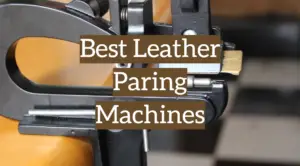

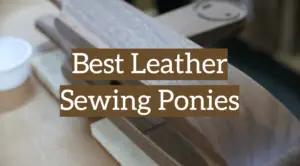

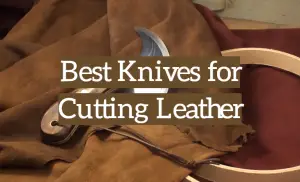
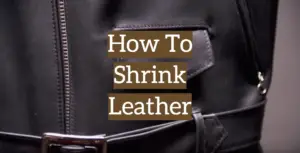
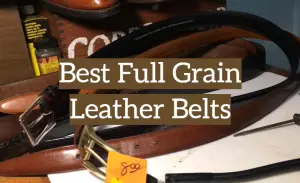

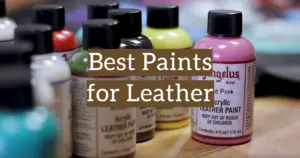




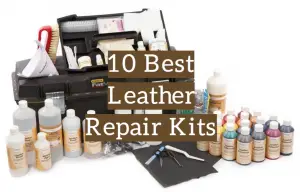
I have been using a cheap riveting tool for a number of years. It is true that you do not need to spend a fortune for a high-quality set. Anything made of durable metals will work, especially for novices working on small projects like myself. Professionally, I think any of these rivet setters for leather would work well.
Hello, Sam! Thanks for your comment.